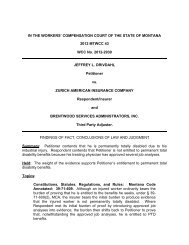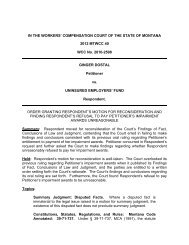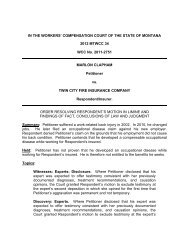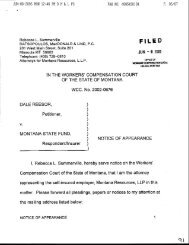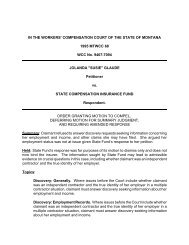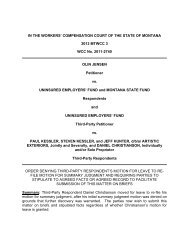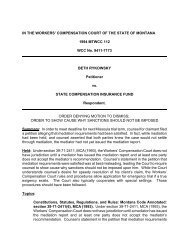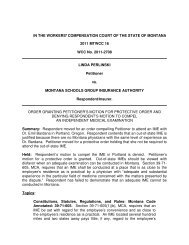2010 MTWCC 16 - Workers' Compensation Court
2010 MTWCC 16 - Workers' Compensation Court
2010 MTWCC 16 - Workers' Compensation Court
Create successful ePaper yourself
Turn your PDF publications into a flip-book with our unique Google optimized e-Paper software.
used among all the mechanics. While Hallquist’s ownership of some equipmentsuggests in an almost negligible way that he had an employer-employee relationshipwith this mechanic, I find this to be only accorded a small amount of weight in the largerpicture of the way the mechanics in the shop cooperatively shared the work space andtheir tools in order to profitably operate their respective businesses.73 Right to Fire: The power to fire is the power to control. 126 Hallquist testified thathe did not have the right to evict a mechanic so long as the mechanic paid his share ofthe overhead. There is no evidence in the record to indicate that Hallquist had the rightto fire Blackwood or Richter. In fact, when Richter left the shop and did not return,Hallquist attempted to contact Richter and then stored his tools indefinitely. If Hallquisthad the right to fire Richter, he likely would have delivered some sort of ultimatum afterRichter stopped showing up to the shop. Since he did not do so, and in light of theabsence of any evidence which suggests that Hallquist ever fired or believed he had theright to fire any mechanic who shared the shop space at 810 East Iron Street, Iconclude that Hallquist did not have the right to fire the mechanics.74 Two of the four control factors weigh in favor of Blackwood and Richter beingindependent contractors, one weighs only slightly in favor of them being employees,and one is neutral. Viewed in their totality, the control factors indicate that Blackwoodand Richter were independent contractors and not employees of P & M Transmission.Engagement in an Independently EstablishedTrade, Occupation, Profession, or Business75 In addition to the control factors, the <strong>Court</strong> must also determine whetherBlackwood and Richter were each engaged in an independently established trade,occupation, profession, or business. 127 In Fliehler v. Uninsured Employers’ Fund, this<strong>Court</strong> concluded that the claimant was an employee, noting that no evidence indicatedthe claimant was engaged in any business prior to being hired by the putative employerand concluding that this lack of evidence was fatal to the putative employer’s claim thatthe claimant was an independent contractor. 128 In the present case, the evidencedemonstrates that Blackwood and Richter were both engaged in the automotive repairbusiness prior to working in the shop at 810 East Iron Street. Hallquist testified thatBlackwood had a large, established clientele which he brought with him and that hepreviously operated a mobile diesel repair service. Hallquist also testified that Richter126 American Agrijusters, 35. (Citation omitted.)127 See 6, above.128 Fliehler, 2001 <strong>MTWCC</strong> 29, 37 (citing Lundberg v. Liberty Northwest Ins. Co., Inc., 268 Mont. 499, 503-04, 887 P.2d 156, 159 (1994)).Findings of Fact, Conclusions of Law and Judgment- 23



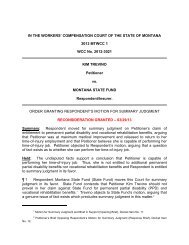
![Bustell v. AIG Claims Service, Inc. [05/03/05] 2005 MTWCC 23](https://img.yumpu.com/49777654/1/190x245/bustell-v-aig-claims-service-inc-05-03-05-2005-mtwcc-23.jpg?quality=85)
![Vallance v. MCCF [07/05/06] 2006 MTWCC 26 - Workers ...](https://img.yumpu.com/48724322/1/190x245/vallance-v-mccf-07-05-06-2006-mtwcc-26-workers-.jpg?quality=85)
